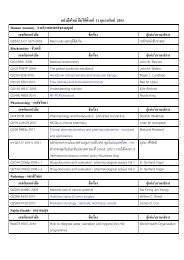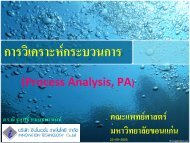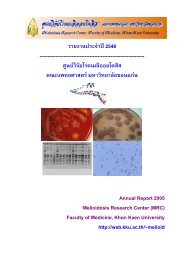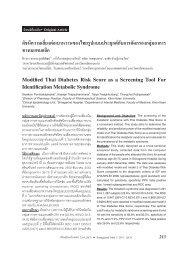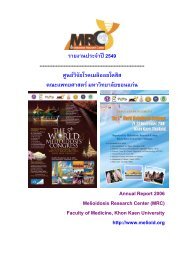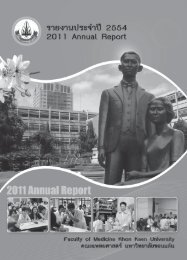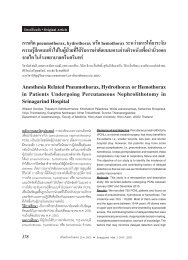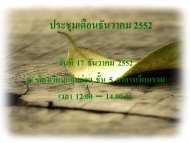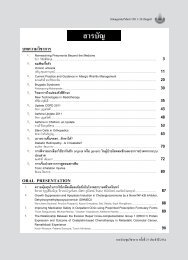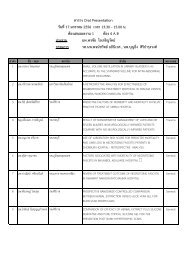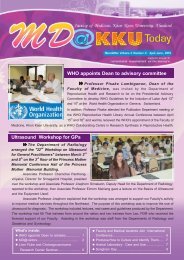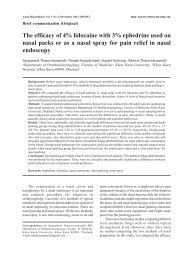Radiation dose from CT scanning: can it be reduced?
Radiation dose from CT scanning: can it be reduced?
Radiation dose from CT scanning: can it be reduced?
You also want an ePaper? Increase the reach of your titles
YUMPU automatically turns print PDFs into web optimized ePapers that Google loves.
Vol. 5 No. 1February 2011<strong>Radiation</strong> <strong>dose</strong> <strong>from</strong> <strong>CT</strong> <strong>s<strong>can</strong>ning</strong>21R. Patient <strong>dose</strong>s and dosimetric evaluations ininterventional cardiology. Phys Med. 2009; 25:31-42.8. Sm<strong>it</strong>h-Bindman R. Is computed tomography safe? NEngl J Med. 2010; 363:1-4.9. Mettler FA Jr, Huda W, Yoshizumi TY, Mahesh M.Effective <strong>dose</strong>s in radiology and diagnostic nuclearmedicine: a catalog. Radiology. 2008; 248:254-63.10. International Commission of <strong>Radiation</strong> Protection.The 2007 recommendations of the internationalcommission on radiological protection. ICRPPublication 103. Ann. ICRP. 2007; 37:1-332.11. Richards PJ, George J, Metelko M, Brown M. Spinecomputed tomography <strong>dose</strong> and <strong>can</strong>cer induction.Spine 2010; 35:430-3.12. IAEA: <strong>Radiation</strong> protection of patients (RPOP):Information for X-ray. Available <strong>from</strong>: http://rpop.iaea.org/RPOP/RPoP/Content/InformationFor/Patients/patient-information-x-rays/index.htm.13. Preston DL, Ron E, Tokuoka S, Funamoto S, Nishi N,Soda M, et al. Solid <strong>can</strong>cer incidence in atomic bombsurvivors: 1958-1999. Radiat Res. 2007; 168: 1-64.14. L<strong>it</strong>tle MP. Cancer and non-<strong>can</strong>cer effects in Japaneseatomic bomb survivors. J Radiol Prot. 2009; 29:A43-59.15. Hoffman DA, Lonstein JE, Morin MM, Visscher W,Harris BS 3 rd , Boice JD Jr. Breast <strong>can</strong>cer in womenw<strong>it</strong>h scoliosis exposed to multiple diagnostic X-rays.J Natl Cancer Inst. 1989, 81: 1307-12.16. Doody M, Lonstein JE, Stovall M, Hacker DJ,Luckyanov N, Land CE. Breast <strong>can</strong>cer mortal<strong>it</strong>y afterdiagnostic radiography: findings <strong>from</strong> the U.S.Scoliosis Cohort Study. Spine. 2000; 25: 2052-63.17. Infante-Rivard C. Diagnostic x rays, DNA repair genesand childhood acute lymphoblastic leukemia. HealthPhys. 2003; 85: 60-4.18. Ron E. Cancer risks <strong>from</strong> medical radiation. HealthPhys. 2003; 85: 47-59.19. Kleinerman RA. Cancer risks following diagnostic andtherapeutic radiation exposure in children. PediatrRadiol. 2006; 36 Suppl 2: 121-5.20. Preston RJ. Update on linear non-threshold <strong>dose</strong>responsemodel and implications for diagnosticradiologic procedures. Health Physics. 2008; 95:541-6.21. Martin CJ. Effective <strong>dose</strong>: how should <strong>it</strong> <strong>be</strong> appliedto medical exposure? Br J Radiol. 2007; 80: 639-47.22. National Radiological Protection Board. Boardstatement on diagnostic medical exposures toionizing radiation during pregnancy and estimates oflate radiation risks to the UK population. Documentsof the NRPB, vol 4, No. 4. Chilton: NRPB 1993.23. Rannikko S, Ermakov I, Lampinen JS, Toivonen M,Darila KTK, Chervjakov A. Computing patient <strong>dose</strong>sof X-ray examinations using a patient size- and sexadjustablephantom. Br J Radiol. 1997; 70: 708-18.24. European Commission. European guidelines onqual<strong>it</strong>y cr<strong>it</strong>eria for computed tomography. EUR 16262EN, Luxembourg 1999.25. European Commission. European qual<strong>it</strong>y cr<strong>it</strong>eria formultislice <strong>CT</strong>. Luxembourg 2004.26. Hatziioannou K, Papanastassiou E, Delichas M,Bousbouras P. A contribution to establishment ofdiagnostic reference levels in <strong>CT</strong>. Br J Radiol. 2003;76: 541-5.27. Kiljunen T, Tietavainen A, Parviainen T, Vi<strong>it</strong>ala A,Kortesniemi M. Organ <strong>dose</strong>s and effective <strong>dose</strong>s inpediatric radiography: patient-<strong>dose</strong> survey in Finland.Acta Radiol. 2009; 50: 114-24.28. Khar<strong>it</strong>a MH, Khazzam S. Survey of patient <strong>dose</strong> incomputed tomography in Syria 2009. Radiat ProtDosimetry 2010; 1-13.29. Choi J, Cha S, Lee K, Shin D, Kang J, Kim Y, et al.The development of a guidance level for patient <strong>dose</strong>for <strong>CT</strong> examinations in Korea. Radiat Prot Dosimetry.2010; 138: 137-43.30. Shrimpton PC, Hillier MC, Lewis MA, Dunn M.National survey of <strong>dose</strong>s <strong>from</strong> <strong>CT</strong> in the UK: 2003.BrJ Radiol. 2006; 79: 968-80.31. Rehani MM. <strong>Radiation</strong> protection in newer imagingtechnologies. Radiat Prot Dosimetry. 2010; 139:357-62.32. Harrison JD, Streffer C. The ICRP protection quant<strong>it</strong>ies,equivalent and effective <strong>dose</strong>: there basis andapplication. <strong>Radiation</strong> Protection Dosimetry. 2007; 127:12-18.33. McCollough CH, Christner JA, Kofler JM. Howeffective is effective <strong>dose</strong> as a predictor of radiationrisk? Am J Roentgenol. 2010; 194: 890-6.34. Christner JA, Kofler JM, McCollough CH. Estimatingeffective <strong>dose</strong> for <strong>CT</strong> using <strong>dose</strong>-length productcompared w<strong>it</strong>h using organ <strong>dose</strong>s: consequences ofadopting International Commission on RadiologicalProtection publication 103 or dual-energy <strong>s<strong>can</strong>ning</strong>.Am J Roentgenol. 2010; 194: 881-9.



